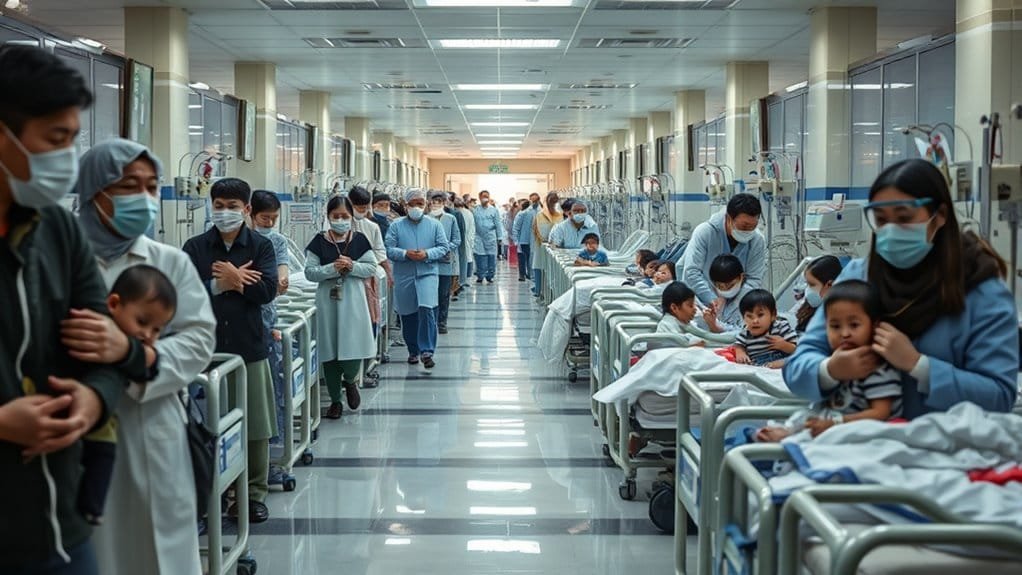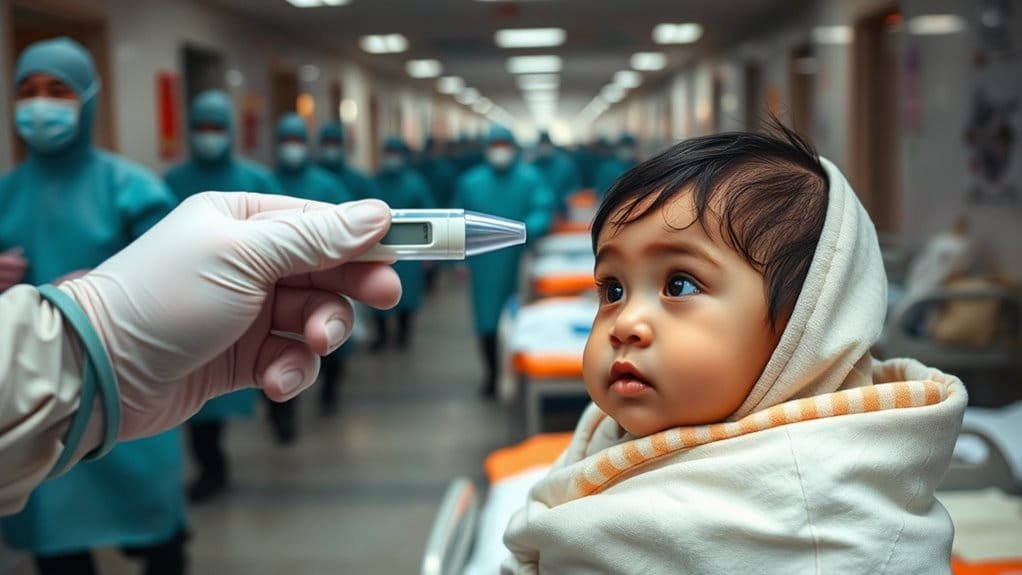You’re likely hearing about a mystery respiratory virus in China, but it’s not entirely unknown – it’s Human Metapneumovirus (HMPV). This highly contagious pathogen is on the rise, particularly among children under 14. HMPV infections can range from mild upper respiratory symptoms to severe lower respiratory tract infections like pneumonia and bronchitis. Transmission occurs via close contact and airborne respiratory droplets, making preventive measures like frequent handwashing and respiratory etiquette vital. The surge in HMPV cases highlights the fragility of global health systems in managing respiratory pathogens. To better understand the risks and how to protect yourself, let’s dig deeper into the details.
Key Takeaway
- HMPV Infection Basics: HMPV causes upper and lower respiratory infections with symptoms like cough, fever, and shortness of breath.
- Transmission Methods: HMPV spreads through close contact and airborne respiratory droplets.
- Vulnerable Populations: Children, immunocompromised individuals, and the elderly are at higher risk for severe HMPV infections.
- Seasonal Patterns: HMPV primarily circulates during winter and spring, with an incubation period of 3 to 6 days.
- Preventive Strategies: Prevent HMPV by frequent handwashing, respiratory etiquette, maintaining distance from sick individuals, and regular surface disinfection.
Disease Overview and Statistics

Understanding symptom management is vital, as HMPV infections can range from upper respiratory symptoms like cough and congestion to more severe lower respiratory tract infections.
These infections are particularly concerning in high-risk groups such as children, individuals with weakened immune systems, and the elderly.
Viral transmission occurs primarily through close contact with infected individuals and airborne transmission via respiratory droplets.
To mitigate this, practicing good hygiene, such as frequent hand washing and proper respiratory etiquette, is essential. With the virus often spreading simultaneously with other respiratory viruses like influenza and RSV during late winter and spring, increased vigilance is necessary.
With no vaccine available, these preventive measures are important in controlling the spread of HMPV and reducing the risk of complications in vulnerable populations.
Recent Surges in China
In northern China, cases of the human metapneumovirus (HMPV) are spiking, particularly affecting children under 14 years of age. This recent surge has sparked public concern and highlights the significance of public awareness and health education. The symptoms of HMPV include cough, fever, and shortness of breath, which can potentially lead to more severe complications like bronchitis and pneumonia.
Given its similarity to other respiratory viruses like respiratory syncytial virus (RSV), understanding the risks and preventive measures is vital.
Northern Chinese provinces are experiencing a significant rise in HMPV cases, and neighboring countries such as Hong Kong, Cambodia, and Taiwan are closely monitoring the situation. China’s National Disease Control and Prevention Administration has reported an increase in respiratory infections, including HMPV, during the winter season.
While the government emphasizes that the surge is consistent with seasonal trends, emergency measures are being implemented to monitor and manage the spread. Health authorities are bolstering monitoring systems, and a pilot program has been launched to track pneumonia of unknown origin.
This proactive approach aims to guarantee the effective management of cases and uphold public health. Regular handwashing with soap and water for at least 20 seconds is a critical preventive measure to reduce the spread of HMPV.
Global Health System Impact

The surge in human metapneumovirus (HMPV) cases in China has underscored the fragility of the global health system, particularly its preparedness to handle emerging respiratory pathogens.
You’re right to feel concerned: despite over 20 years since its discovery, HMPV still lacks a vaccine, making it a tough respiratory illness to manage globally.
The recent uptick has strained healthcare facilities, particularly children’s hospitals. This winter, you can expect more seasonal infections, emphasizing the need for vigilance and preparedness.
Key points to take into account include:
- Vaccine development challenges: Despite ongoing research, no vaccine has been developed, leaving healthcare systems reliant on supportive therapies like oxygen and corticosteroids.
- Healthcare system strain: The surge in respiratory infections has overwhelmed Chinese hospitals, with children under 14 being disproportionately affected.
- Global cooperation: Chinese and Indian authorities, alongside the WHO, are enhancing early detection and monitoring to tackle emerging pathogens.
- Seasonal challenges: HMPV peaks during winter and spring, unlike COVID-19, which can spread year-round due to evolving variants. The incubation period of HMPV ranges from 3 to 6 days, adding complexity to its management.
Given these challenges, it’s essential to stay informed and take preventive measures to reduce the spread of HMPV.
Global Response and Monitoring
You’re actually in the midst of a dynamic global health situation, with China’s HMPV surge triggering international health surveillance and cross-border disease management efforts.
Countries like Hong Kong, Cambodia, and Taiwan are keeping a close watch, requesting timely updates from the WHO to manage their responses effectively. The primary focus is on managing symptoms since there is no specific treatment available for HMPV.
International Health Surveillance
International Health Surveillance (Global Response and Monitoring)
Effective international health surveillance is essential in the face of mysterious outbreaks like the recent respiratory illness in China. It relies on strong international partnerships and surveillance innovations to detect and respond to emerging health threats. The World Health Organization (WHO) plays a pivotal role in leading global public health surveillance, gathering information from formal and informal sources through its country and regional offices.
Key components of international health surveillance include:
- Global networks: The Global Outbreak and Response Network (GOARN) collaborates with institutions to rapidly identify and respond to outbreaks.
- Disease-specific surveillance: The Global Influenza Surveillance and Response System (GISRS) and the Global Polio Laboratory Network (GPLN) focus on specific diseases, sharing viruses, data, and benefits globally.
- Technology integration: Advances in data sharing, field-based diagnostic tests, and statistical methods enhance surveillance in low-income and middle-income countries. The critical importance of data quality is underscored by the need for accurate and timely health information to inform public health decisions.
- Standardized frameworks: WHO provides a framework for effective, efficient, and sustainable surveillance systems, integrating all public health surveillance activities.
These elements work together to guarantee early detection and swift response to public health threats, safeguarding global health security.
Cross-Border Disease Management
Facing the challenges of mysterious outbreaks like the recent respiratory illness in China underscores the importance of robust cross-border disease management strategies. Effective management strategies focus on detecting and responding to ill travelers at points of entry, identifying and addressing health risks associated with the movement of people, animals, and cargo across borders, and strengthening public health information sharing between neighboring countries.
Key Strategies for Cross-Border Disease Management
| Strategic Focus | Description | Implementation |
|---|---|---|
| Detect and Respond | Detecting and responding to ill travelers at points of entry | Developing public health emergency response plans and procedures |
| Health Risk Identification | Identifying health risks associated with movement across borders | Collecting and analyzing data to understand population movement |
| Cross-Border Collaboration | Strengthening public health information sharing between neighboring countries | Developing formal public health agreements and procedures |
Preventive Measures and Care

Implementing robust preventive measures is essential to mitigate the spread of the HMPV virus.
You can greatly reduce your risk of contracting HMPV by following these preventive strategies.
Key Preventive Steps:
- *Wash Your Hands Often*: Clean your hands frequently with soap and water for at least 20 seconds. Regular hand washing is vital to prevent the spread of HMPV.
- *Practice Respiratory Etiquette*: Cover your mouth and nose using tissue paper or a bent elbow when coughing or sneezing. This simple practice helps save others from getting infected.
- *Avoid Close Contact*: Keep distance from people who are sick. Refrain from kissing others when sick and avoid sharing cups and eating utensils to prevent the spread of HMPV.
- *Clean Surfaces*: Regularly disinfect frequently-touched objects and surfaces. Use strong surface cleaners to kill the virus on surfaces like doorknobs and shared toys.
HMPV can spread through respiratory droplets, making it important to follow these preventive steps to minimize the risk of infection.
Comparative Analysis and Insights
The outbreak of human metapneumovirus (HMPV) in China has drawn comparisons to the COVID-19 pandemic, not only due to its similar symptoms but also due to its potential to overwhelm healthcare facilities.
As cases surge, particularly among children in northern Chinese provinces, concerns about healthcare capacity have grown. The situation has sparked fears of overcrowded hospitals, prompting officials to implement emergency measures to monitor and manage the spread of HMPV.
Understanding HMPV transmission is vital to preventing its spread. It’s primarily spread through respiratory droplets or contact with contaminated surfaces, emphasizing the need for vigilant hygiene and social distancing.
Unlike COVID-19, HMPV typically peaks during winter and spring, aligning with seasonal respiratory virus patterns. However, its impact can be severe, especially among vulnerable groups such as children and those with weakened immune systems. For example, data from China indicates that HMPV was linked to 6.2% of positive respiratory tests.
With no vaccine available, focusing on preventive measures and strengthening healthcare capacity is essential to mitigate the outbreak’s effects.
While the WHO hasn’t flagged the situation as a global health emergency, neighboring countries are closely monitoring the situation, underscoring the importance of preparedness and vigilance.
Seasonal Preparedness and Alertness**

- Regular Surveillance: Conduct regular surveillance to monitor respiratory virus activity and trends.
- Immunization Recommendations: Follow CDC recommendations for immunizations against flu, COVID-19, and RSV.
- Testing and Treatment: Utilize available tests and treatments for respiratory viruses to reduce severe illness and hospitalizations.
- Community Measures: Implement common-sense measures like masking, physical distancing, and handwashing to prevent virus transmission.
Facilitating timely administration of recommended seasonal vaccinations is key to preventing illness and reducing severity.
Developing robust preparedness plans integrates previous health emergencies, leading to more effective responses to future pandemics.
Develop and update preparedness and response plans for pandemics caused by respiratory pathogens.
Stay updated with public health alerts and advisories for seasonal respiratory virus activity.
Frequently Asked Questions
How Does HMPV Spread From Person to Person?
You can get HMPV through respiratory droplets when an infected person coughs or sneezes near you, by direct contact like touching or shaking hands, and by touching contaminated surfaces then touching your face.
What Are the Typical Symptoms of an HMPV Infection?
About 16% of children with HMPV may get a serious complication like pneumonia. If you catch HMPV, you’ll typically experience symptoms like a runny nose, cough, sore throat, fever, and shortness of breath, indicating a respiratory illness.
Is There a Treatment Available for HMPV Infections?
You’ll manage HMPV symptoms with supportive care, as there’s no specific antiviral treatment or cure. You can use over-the-counter medications for pain, fever, and congestion, and severe cases may require corticosteroids and oxygen therapy.
Can Adults Contract HMPV if They Have Already Had It as Children?
You can contract HMPV as an adult even if you had it as a child, since reinfection is likely due to incomplete immunity; up to 100% of adults have been exposed, yet reinfections occur throughout adult life.
How Can Individuals Protect Themselves From Contracting HMPV at Home?
You can protect yourself from contracting HMPV at home by following good hygiene practices, such as regular handwashing and surface disinfection, maintaining proper air circulation, and avoiding close contact with sick individuals who show respiratory symptoms.
Conclusion
You’re facing a tidal wave, not just a ripple: China’s HMPV surge is a stark reminder of how quickly respiratory diseases can overwhelm healthcare systems. With millions of cases globally each year, it’s essential for global health bodies to remain vigilant. As winter sets in, outbreaks like these underscore the need for robust preparedness, constant monitoring, and swift action to protect the most vulnerable—especially infants and young children. Stay informed and take preventive measures to safeguard against this common yet potentially severe virus.
Dr. Capsule Germ Free Box UV C Sterilizer Box for Mobile Phone sanitization, Earphone, Mask, Baby Pa
Amazon Brand - Presto! Antiseptic Liquid | 1.5 Litre | 500 ML X 3 Packs | Home Sanitization, First A
Daluci Anti Pollution N95 Reusable Unisex Non Woven fabric Face Mask, Ear Loop Style (Pack of 10) Pr
ONSAFE Latex Medical Examination Disposable Powdered Hand Gloves | Non-Sterile Single-Use Gloves for
CARE VIEW Careview Hand Gloves | Pack of 200 | Transparent Gloves | Universal Size Gloves | For Gard
Omron Glass Mc 246 Digital Thermometer With Quick Measurement Of Oral & Underarm Temperature In Cels
















